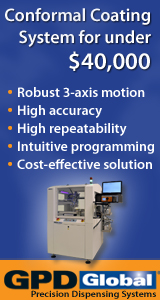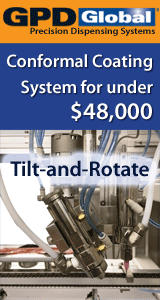Printed Circuit Board Assembly & PCB Design Forum
SMT electronics assembly manufacturing forum.
- SMTnet
- »
- Electronics Forum
- »
- Universal Genesis Inline7
Universal Genesis Inline7
Views: 6095
![]() When trying to save a program onto a floppy disk I get this ...
- Nov 14, 2018
by
Reckless
When trying to save a program onto a floppy disk I get this ...
- Nov 14, 2018
by
Reckless
![]()
![]()
![]() hello Reckless, someone from IT should have better idea what...
- Nov 15, 2018
by
bukas
hello Reckless, someone from IT should have better idea what...
- Nov 15, 2018
by
bukas
![]()
![]()
![]() Hello,
u_APE.exe is a file located in your UPS folder, in...
- Nov 15, 2018
by
SMT Division
Hello,
u_APE.exe is a file located in your UPS folder, in...
- Nov 15, 2018
by
SMT Division
![]()
![]()
![]() It turns out the issue was programming in milimeters instead...
- Nov 16, 2018
by
Reckless
It turns out the issue was programming in milimeters instead...
- Nov 16, 2018
by
Reckless
![]()
![]()
![]() Hi Reckless, good luck in your new machine adventure!
...
- Nov 16, 2018
by
Robl
Hi Reckless, good luck in your new machine adventure!
...
- Nov 16, 2018
by
Robl
![]()
![]()
![]() The adventure never ends. I have the sapphire coming next w...
- Nov 16, 2018
by
Reckless
The adventure never ends. I have the sapphire coming next w...
- Nov 16, 2018
by
Reckless
![]()
![]()
![]() If you are gang picking from 6 reels in a row for the same p...
- Nov 16, 2018
by
Robl
If you are gang picking from 6 reels in a row for the same p...
- Nov 16, 2018
by
Robl
![]()
![]()
![]() Thanks for the explanation!
I'm trying to google and find...
- Nov 16, 2018
by
Reckless
Thanks for the explanation!
I'm trying to google and find...
- Nov 16, 2018
by
Reckless
![]()
![]()
![]() OK, so all GEM Machines & MG were built by Yamaha, and impor...
- Nov 19, 2018
by
Robl
OK, so all GEM Machines & MG were built by Yamaha, and impor...
- Nov 19, 2018
by
Robl
![]()
![]()
![]() Your Sapphire is a Yamaha YV112-III.
...
- Nov 19, 2018
by
Robl
Your Sapphire is a Yamaha YV112-III.
...
- Nov 19, 2018
by
Robl
![]()
![]()
![]() Definitely helps! I came across this Yamaha newsletter ment...
- Nov 19, 2018
by
Reckless
Definitely helps! I came across this Yamaha newsletter ment...
- Nov 19, 2018
by
Reckless
![]()
![]()
![]() The old YV-112 equates to the old Philips Comet, which had 1...
- Nov 19, 2018
by
Robl
The old YV-112 equates to the old Philips Comet, which had 1...
- Nov 19, 2018
by
Robl
![]()
![]()
![]() Your thought about cheating like mad expresses what was goin...
- Nov 19, 2018
by
Reckless
Your thought about cheating like mad expresses what was goin...
- Nov 19, 2018
by
Reckless
![]()
![]()
![]() Thanks for clarifying this for me.
I have one component...
- Nov 19, 2018
by
Reckless
Thanks for clarifying this for me.
I have one component...
- Nov 19, 2018
by
Reckless
![]()
![]()
![]() Ahh but you're missing the key points.
The YSM40 is in no...
- Nov 20, 2018
by
Spoiltforchoice
Ahh but you're missing the key points.
The YSM40 is in no...
- Nov 20, 2018
by
Spoiltforchoice
![]()
![]()
![]() Great explanation! In my operation I have all tiny chips, 1...
- Nov 20, 2018
by
Reckless
Great explanation! In my operation I have all tiny chips, 1...
- Nov 20, 2018
by
Reckless
![]()
![]()
![]() NXT's are never meant to be used in isolation - I've never s...
- Nov 20, 2018
by
Robl
NXT's are never meant to be used in isolation - I've never s...
- Nov 20, 2018
by
Robl
![]()
![]()
![]() Talked with the local Yamaha rep. YSM40 has a real world sp...
- Nov 21, 2018
by
Reckless
Talked with the local Yamaha rep. YSM40 has a real world sp...
- Nov 21, 2018
by
Reckless
![]()
![]()
![]() You won't find many Fujis as people don't tend to let them g...
- Nov 21, 2018
by
Robl
You won't find many Fujis as people don't tend to let them g...
- Nov 21, 2018
by
Robl
![]()
![]()
![]() What are they running?
The YSM and other current Yamahas ...
- Nov 21, 2018
by
Reckless
What are they running?
The YSM and other current Yamahas ...
- Nov 21, 2018
by
Reckless
![]()
![]()
![]() Probably just evolved - just different needs at different ti...
- Nov 22, 2018
by
Robl
Probably just evolved - just different needs at different ti...
- Nov 22, 2018
by
Robl
![]()
![]()
![]() Do you remember how tall if a component works on the sapphir...
- Nov 23, 2018
by
Reckless
Do you remember how tall if a component works on the sapphir...
- Nov 23, 2018
by
Reckless
![]()
- SMTnet
- »
- Electronics Forum
- »
- Universal Genesis Inline7







